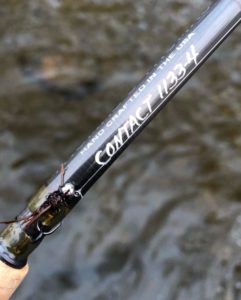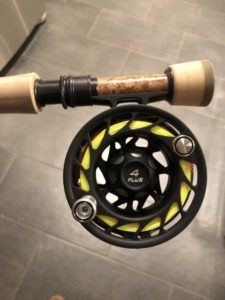 “The Rod You Will Eventually Own.”
“The Rod You Will Eventually Own.”
That’s a bold assertion, but, a year ago when I started reading reviews of the Thomas and Thomas Contact Nymph Rod, I couldn’t help but think that the T&T tagline was correct. That assertion turned out to be true in my case, when I recently purchased the 11’3″ three-weight.
These rods are definitely growing in popularity and for good reason. There are some comprehensive reviews already (prior one here), but, I thought I would share my experience, both leading up to the sale and after a few weeks of use.

In all of the reviews I read, one particular detail really piqued my interest: accuracy. Everyone raved about how accurate the T&T Contact is. I really liked my 11’Sage ESN, but, I often struggled to make an accurate presentation.
I’d often miss my target completely, and the rod was very slow to recover. Nevertheless, I appreciated the reach of the ESN’s length and the tremendous power in the butt section.
I followed the common recommendation to pair the ESN with an oversized reel, in my case a Sage 3280, in an attempt to achieve the right balance. While the rod balanced fairly well, it was still a heavy combo, and I felt it in my right arm after a long session on the river.
I found myself eyeing the rod rack at UpCountry Sportfishing every time I stopped in for tying supplies. As a rod builder myself, I was impressed with the high-quality components and the craftsmanship, although I was hesitant to spend the money when I owned a perfectly good rod that I was generally happy to fish.
Then it dawned on me: I’ll keep the cost down by building one.

So, I called Thomas and Thomas and had a pleasant conversation with John Carpenter. I learned that they sell the blanks for about half the price of the finished rod. Good news, but, I build surf spinning rods, not fly rods.
Building a fly rod would be a new endeavor, and I would need more information. John and I chatted at length about the rod, and he obliged all of my detailed rod building questions. I was conflicted about whether to go with an up-locking or down-locking reel seat.
Down-locking seats move the reel closer to the butt and allow you to balance the rod with a lighter reel as opposed to fishing an oversized or heavier reel as I did on my ESN.
There are differing schools of thought here, but the fly shop only carried standard up-locking models so I couldn’t do a comparison for myself with the reel I intended to use.
Thankfully, John forwarded me an email on the reel-seat subject from T&T rod designer Joe Goodspeed that gave me plenty of info to make an informed decision. Up-locking it would be. I appreciated the great customer service, and I liked the idea of being able to do business with a local company right here in New England.
Next stop was another great local company, REC Components in Stafford Springs, CT. I began pricing out the high quality titanium RECOIL guides that T&T uses on their factory rod. I browsed different combinations of reel seats with various wood spacers.
When it was all said and done, I had an online shopping cart full of components worth as much as some entry-level rods. But these high quality, lightweight components are a necessary part of what makes the Contact a great rod.
When I totaled everything, including a batch of lite-build epoxy, hook keeper, thread, and a rod tube, I was about $100 bucks short of the price of the factory rod.
Then another thought dawned on me; the factory rod is a tremendous value.
Although I build rods as a hobby, there’s a fine line where your hobby starts to feel like work, and I realized I was crossing it. I already had two rod-building projects to complete, I didn’t need a third, especially when there was no real customization involved.
Thomas and Thomas did everything right in designing the Contact, right down to the western-style grip, which allows your casting hand index finger to transition onto the blank for enhanced feel. They had all of the bases covered.
I sent John another email thanking him for his time, shared my thoughts on the value of their product and told him of my decision to eventually purchase a factory rod from UpCountry.
When the time came, I felt good about the purchase and even better about giving my money to a great local fly shop as I walked out, rod tube in hand.
As an unexpected surprise, when I got home I discovered the rod in the tube actually had a down-locking reel seat. Apparently it was shipped in error, but it worked out well because I was able to compare the two reel seats with a Hatch 4 Plus and found the difference in the point of balance to be negligible.
With the decision for me now reduced to a matter of aesthetics, I decided that I preferred the look of the forward reel position on the up-locking seat and the additional length would keep my reel out of the dirt if I propped the rod up against a tree, etc.
Regarding performance, I can attest to the claims already made here and elsewhere. The Contact is incredibly accurate and sensitive. I could even feel the ticking of my nymphs through the cork grip! Although three inches longer than my ESN, the new rig feels considerably lighter without sacrificing power in the butt section.
The Contact has been an absolute joy to fish, and I’m looking forward to giving it a good workout in the coming months.

Discover more from BlogFlyFish.com
Subscribe to get the latest posts sent to your email.

Excellent review! I have been contemplating a purchase of this T&T model for a year as a replacement for my 11’ESN which killed my arm to fish all day. I currently use a 10’ESN for the bulk of my nymphing.
A couple of questions: What was T&T’s advice on up or down locking and your reason for your choice? What is the butt strength like as compared to the ESN? In a pinch how would it fish size 14-18 drys?
I look forward to hearing some success stories on the river and thanks again for this detailed review.
Steve, the general consensus I found in talking to T&T and guys who fish this rod was that the down-locking seat wasn’t required to obtain good balance as it might be on other rods. The rod was designed to balance with a standard sized (weight) reel, not a heavy reel. Guys typically prefer down locking seats In order to use a lighter reel. I chose the up-locking seat because when comparing the balance point between the two rods (up and down versions), I found no significant difference. With the Hatch 4, both configurations put the balance point in the fore grip where I want it, so it became a matter of aesthetics and I prefer having a bit of extra length with the fighting butt as you can see in the photos. If you’re really on the fence, I would recommend comparing them side by side with the reel you plan to use.
Regarding power in the butt section, I was impressed with my ESN and have been similarly impressed so far with the T&T.
I have no experience with dries yet, although I know many guys have done it successfully.
I did throw a streamer with no problem.
Thanks for the detailed response. I’m going to try one at UpCountry prior to pulling the trigger. Might impress the wife by leaving with three fly rods and coming home with one! Heh, Heh!!
I don’t think you’ll regret it.
Geat review. Has anyone tried the 2wt version of the Contact yet?
Considered buying one, would love to see a comparison between the 2 and 3 weight myself.
I bought my first nymphing rod this winter…unused T&T ATS 11′ 4 wt. I am hoping to try out nymphing with a purpose built rod. I got an insane deal so I could not pass it up. Do you find the 11′ a problem in some areas? C.
Have not found the length to be an issue; the situational awareness takes a bit getting used to, but the added reach helps in all applications, from Czech style to long range techniques. The T&T Contact recovers quickly so it doesn’t feel like a noodle rod.
I am curious if any nymph rod designer has considered an extended butt section the length of the average forearm. Even with a balanced reel, physics are fighting you with the fulcrum at the end of the lever. This may completely mess up fly casting in the traditional way (or not), but would be much more comfortable to euronymph.
Not a physics whiz, so won’t argue there, but I will say weight becomes a problem no matter how well it’s balanced. Adding a forearm’s length of butt material would make for a heavier setup. Case in point, my ESN balanced well, but was heavy and I felt it. Don’t get me wrong, we’re talking the difference between great and excellent, in my opinion, when comparing those two rods. But to your point, that’s part of the reason I like the feel of an additional few inches of butt section on the up-locking reel seat; it locks under my wrist and forearm nicely.
Take an 8ft 2×4 and hold it like a fly rod. Then do the same but hold it a forearms distance from the end. Just a thought.
The t&t sounds a great rod from your review and previous ones posted here.
I get it – interesting concept – would be 12ft or more.
FWIW, the Tridentflyfishing.com site has a shootout on a bunch of EuroNymphing Rods. Some hard facts and some subjective opinions.
Awesome!